Статьи журнала - Современные проблемы сервиса и туризма
Все статьи: 1121

Статья научная
The article reveals modern trends in the development of tourism both in Russia and abroad. The authors first of all provide an overview of trends emerging in the pre-coronavirus period and associated with a shift from mass-tourism to its sustainable forms. The study as well underlines the problems that emerged during the COVID-19 pandemic, both in consumer demand and by tourism providers. Particular attention is paid to the types of domestic tourism, which, according to experts, will receive an additional impulse for development in the post-coronavirus period. The practical aspects of organizing weekend itineraries as a promising type of domestic tourism are considered on the example of the internal regions of the Kaliningrad region of Russia located on the mainland adjacent to the Curonian lagoon. According to the results of the study, an integrative model of the formation of a recreational effect by active tourism technologies was developed taking into account the concept of sustainable development in post-coronavirus conditions. Field studies were carried out as part of the implementation of the international project of the Lithuania-Russia Cross-Border Cooperation Programme 2014-2020 ““Сommon Heritage of Curonian lagoon: from Extraordinary to Familiar - CROSS-HERITAGE».
Бесплатно

Sea cruise tourism in specially protected natural areas of Arctic
Статья научная
The article examines the importance of sea cruise tourism in protected areas and determines the role of sea cruise tourism in the Arctic PAs as a priority and competitive type of tourism. The author analyzes the protected areas of the subjects of the Russian Arctic and identifies those that can be used for organizing sea cruise tourism. For organizing arctic cruises the author recommend to use cruise sea and scientific expedition ships. The article represents the results of SWOT analysis and identifies the development prospects for the of sea cruise tourism, in particular in the protected areas of the Arctic on the basis of the “Strategy for the development of tourism in the Russian Federation until 2035”. The author reviles the strengths and opportunities of the Arctic for the development of sea cruise tourism in protected areas, determines its main function. As form of ecological tourism, it is scientific and expeditionary activity aimed at the preservation of natural biodiversity, the development of the maritime transport structure, and the receipt of income from this type of tourism.
Бесплатно

Статья научная
The relationship between transportation and tourism is inseparable, and both are services that provide user experiences. The systemic view has been paradigmatic for the treatment of this interface. However new approaches have emerged, including others based on the larger web of mobility. In order to create a new research agenda on Transportation and Tourism involving Brazil, it is necessary to investigate the scientific production to verify the state of the art, which is the main objective of this study. This research is exploratory and descriptive of a qualitative nature, and it was carried out through a bibliographic survey and software support was used for the spreadsheet, textual and geographical approaches. As for the results, on the one hand, this snapshot allows us to understand the epistemological advances. On the other hand, it provides indications for these advances to be incorporated into the discussions on planning and management of transportation and Brazilian tourist destinations, constituting premises of the Applied Social Sciences. Besides, from the state of the art identified, it is possible to launch new interdisciplinary perspectives on the future of research, proposing a strategic agenda for research in tourism and transportation, based on creativity and innovation in both the theoretical and methodological fields.
Бесплатно
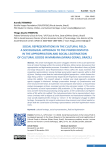
Статья научная
This article investigates the power struggles inherent in the social representations of cultural heritage within the context of Mariana, Minas Gerais, focusing on their appropriation and legitimation processes. Grounded in Pierre Bourdieu’s theory of fields and Serge Moscovici’s Social Representations Theory (SRT), the study examines how competing representations among heritage preservation agents operate within a field of forces. Findings reveal that the institutional (official) perspective – which dictates heritage listing criteria – is predominantly shaped by the hegemonic representations dominating this subfield. The research adopts a multiple case study approach, analyzing agents engaged in Mariana’s heritage preservation through: a) Questionnaires and semi-structured interviews; b) Systematic non-participant observation; c) Documentary analysis (newspaper archives, municipal records). Key outcomes include: 1) The contextual dynamics of social representation (SR) production; 2) The typology of representations and their hierarchical positioning among agents; 3) The contestation and legitimization of SRs within the subfield. The study demonstrates that a representation’s dominance correlates with its degree of social dissemination and institutional validation. The most socially legitimized SRs emerge as "victors" in the ideological struggle to define heritage. Consequently, the research underscores how economic and cultural capital underpin both the construction of heritage representations and their legitimation mechanisms.
Бесплатно
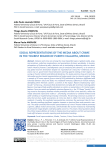
Social Representations of the Media About Crime in the Tourist Region of Puerto Vallarta, Mexico
Статья научная
Violence and crime are among the most impactful topics in global media, shaping narratives, collective imaginations, and perceptions of places worldwide. In tourism, perceptions of (in)security play a decisive role in motivating or deterring visits to a destination. Mexico presents a paradigmatic case for analyzing this dynamic, as it remains a top global tourism destination despite its reputation for insecurity—evidenced, for instance, by U.S. government travel advisories warning against visiting certain regions. Focusing on Puerto Vallarta and Bahía de Banderas, this study examines how print and digital media construct social representations of violence and crime in a tourist context. Using a sample of 97 news reports (from a total of 622) published by Noticieros (affiliated with Televisa) between 2015 and 2020, we employed Iramuteq software for lexical analysis, identifying three thematic clusters: 1) Crimes in the region: Reports emphasizing "spectacular" crimes (e.g., shootouts) that deviate from everyday life; 2) Crimes involving public figures: Coverage of high-profile individuals as victims or perpetrators; 3) Criminal organizations: Focus on cartels and globally notorious figures (e.g., the "El Chapo" family). Findings reveal a discrepancy between media portrayals and local crime statistics, where the media selectively represents violence – prioritizing sensational or celebrity-linked events while omitting or euphemizing everyday criminality. This framing constructs a partial reality that anchors public perceptions of crime but fails to reflect the lived insecurity of residents. Crucially, this mediated representation minimizes the perceived risks for tourists, thereby avoiding significant negative impacts on tourism flows and economic revenue. The study concludes that media representations of crime in Puerto Vallarta promotes a generic, diffuse notion of insecurity, which benefits the tourism industry by maintaining an attractive image despite underlying safety concerns. This raises critical questions about the ethical responsibilities of media in shaping tourist perceptions and the socioeconomic trade-offs between accurate reporting and destination branding.
Бесплатно
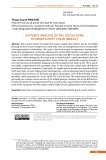
Systemic analysis of the Juiz de Fora tourism supply chain (Brazil)
Статья научная
This research aimed to analyze the tourism supply chain (TSC) in Juiz de Fora (MG), focusing on its structural components, main links, internal management process and possible inter-organizational relationships. We used a literature review on operations management, production management, production planning and control (PCP), logistics and supply chain on tourism, to analyze and compare the proposed concepts and offer a model related to the tourism product. Methodologically, this study used a mixed research, mainly quantitative but with some complementary qualitative questions. It was conducted a systematic mapping, through a non-intentional and probabilistic sampling with 100 companies that make up the TSC in Juiz de Fora (MG), complemented with qualitative data, on the reasons for certain types of behavior and practices of these companies. Empirically, the supply chain in question was considered from all its main links, namely: lodging, food, travel agencies, cultural equipment and transportation. Its analysis was carried out on the basis of 6 blocks of questions, each of them having a set of questions, which generated an “x-ray” of the TSC in Juiz de Fora. The results show that despite generating an average annual revenue of 3.6 million/year per company, the sector still lacks internal improvement in management practices, as well as inter-organizational integration, which leads to the conclusion that the output could be better if such optimizations were introduced.
Бесплатно
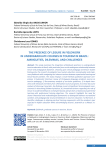
Статья научная
This study examines the integration of fieldwork practices in undergraduate tourism education in Brazil, with particular focus on the ambiguous relationship between leisure and pedagogical objectives. Drawing upon critical pedagogy and leisure studies frameworks, the research investigates how tourism educators conceptualize and implement fieldwork while navigating the inherent tensions between experiential learning and leisure-based activities. The study employs a multi-method qualitative approach comprising: 1) Systematic literature review of Portuguese-language academic sources on tourism pedagogy; 2) Documentary analysis of curricular guidelines; 3) In-depth interviews with 34 faculty members from 19 Brazilian tourism programs; 4) Critical discourse analysis of interview transcripts. Key findings reveal: a) Significant terminological inconsistencies in describing fieldwork practices; b) Unresolved tensions regarding the role of leisure in academic fieldwork; c) Divergent faculty perspectives on balancing experiential learning with professional training objectives. The research highlights the need for clearer theoretical and methodological frameworks to distinguish between recreational activities and pedagogically structured fieldwork in tourism education. Furthermore, it identifies challenges in aligning practical training components with the academic rigor expected in higher education while acknowledging leisure's potential as a didactic resource.
Бесплатно
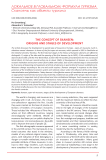
The concept of skansen: origins and stages of development
Статья научная
The article discusses the development a special type of museums in Europe - open-air museums. Such in- stitutions named «skansen» in honor of the first open-air museum, which opened in 1891 in Stockholm at the initiative of Arthur Hazelius. The five historical stages in the history of European skansens are offered to distinguish: 1) origin of the idea and the opening of the first skansen (up to 1891); 2) the establishment of skansen (from 1891 until the First World War); 3) Inter-War Period (the period between the First and Second World Wars); 4) Post-war reconstruction (up to about 1960); 5) Development of skansen as a scientific- research institution and tourism center (from 1960s until today). Each of the selected stage is characterized by its process of deepening and expansion of activity of skansens as special kind of museum establishments. Museums change according to the era and social requires. Skansen emerged in response to the disap- pearance of the traditional economic system and national culture under the influence of the processes of industrialization and globalization. Today skansen is the effective means of translation to new generations an appropriate national historical and cultural identity, traditional way of life of the people. Skansen (open- air museums) is important tool of intercultural and inter-civilizational dialogue. Such museums are also a means of communication, which able to withstand to many cliches and misconceptions imposed by the mass culture. Today the organization of open-air museums is one of the most promising and effective ways to preserve historical and cultural heritage. This type of museum has got status of «museum of the future». The article briefly discusses the most interesting and popular open-air museums as tourist destinations of the Nordic countries.
Бесплатно
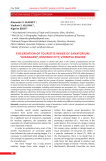
The creation of touristic image of sanatorium “Avangard”, Nemirov city, Vinnitsa region
Статья научная
Modern ways of promoting tourism product in Ukraine take place in the context of globalization and the transition to the Information Society and increase competition for consumers. It is hard to overestimate the role of tourism in socio-economic development in different regions. Tourism is a very specific sector of the economy. Tourism is regarded as one of the most profitable and intensively developing branches of the world economy. Modern tourism takes an increasingly important place in the economy of Ukraine. In Ukraine in the first half of 2017, 6.3 million tourists entered, which is 8.7% more than in the same period of 2016 (5.8 million foreigners). Crucial conditions for survival on rigid travel market are the need for concentration on a high-quality tourism product, able to satisfy the highest demands of modern tourism consumer, and promote itself to the market. A significant role in this process is played by four groups of factors: megafactors (climatic condition of the area), macrofactors (country its level of economic and political development), mezofactors (region destination, its social and touristic features a variety of tourism product) and microfactors (human resources, comfort and service, product promotion technologies, including social networks are prominent, etc.). The paper is aimed at creating the touristic image of sanatorium and resort located in the city Nemirov, Vinnitsa region, Ukraine using different mezofactors, information technology and the Internetprepared for promoting tourism product of these destinations. The authors focus their attention on the development of sanatorium “Avangard” located in the city Nemirov, namely on the creating of itsimage on the tourist market. Main purpose of the work is to investigate image of sanatorium and resort located in the city of Nemirov of Vinnitsa region, which contribute to attract the visitors or tourists, and consistently promote this entity on the market using different marketing communications.
Бесплатно

The current state of children's tourism in Lipetsk region
Статья научная
The article examines the main trends in the development of children’s tourism in the Russian Federation, identifies the obstacles to children’s tourism’s fulfillment of its significant role: to participate in the upbringing, education and health improvement of the younger generation. The destruction of the socio-economic system of the Soviet state radically changed the structure and approaches to organizing children’s tourism in the Russian Federation. The author presents a generalized picture of negative processes in children’s tourism, based on the results of statistical data over the past 5 years and the results of recent scientific research. At the state level, a number of measures are being taken to resolve the situation, which relate to changes in the regulatory framework and in organizational and management structures. These numerous attempts, however, do not create conceptual foundations in the development of children’s tourism, do not have a systemic nature and, as a result, do not give the desired effect. Regional specifics in the children’s tourism development reflect the national trends. This is clearly demonstrated by the experience of the Lipetsk region, in which, along with negative trends, the author traces a number of positive points: an increase in the number of children who have rested in children’s health camps, the continuation of the traditions of tourism and local history work on the basis of additional education institutions and within the framework of organizing one-day and multi-day tourist trips, activities of the Argamach Archaeological Park and The Forest Park. The article identifies a number of organizational decisions and initiatives as promising areas (the creation of the Committee for the Development of Children’s Tourism in February 2020, the results of the Committee’s meetings in 2020), which should raise the level of development of children’s tourism.
Бесплатно
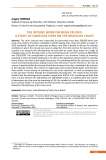
The intense work on mega cruises: a study of cabotage ships on the Brazilian coast
Статья научная
The cruise industry was responsible for generating more than 500,000 direct jobs (crew and workers of onshore companies) and for paying more than $21 billion in wages in 2019 worldwide. Despite the expressive numbers, very little is guided or discuss the working conditions to which the crew of sea cruises is subjected. From this context, the objective of this research is to measure the intensification of crew work on cruise ships, based on a study of cabotage ships on the Brazilian coast, in the period between the summer seasons of 2013/2014 and 2019/2020. The intensification of work appeared in the economic history of humanity especially in times of capital expansion or at times when legislation imposed limits on working hours. If there are limits to the length of journeys, the technology will be the instrument used to ensure increased productivity, making it work more intensely in shorter intervals. In the case of cruises, it was found that the intensity of work has increased over time, according to the increase in the capacity of ships. This is because megacruises have proportionally fewer crewmembers than smaller cruises aiming at reducing the cost of the operation, as well as cheeping trips to the consumer market, through the massification of production. The results of this research indicate that the passenger/crew member ranged from 3.09 to 3.34, considering all ships that were in Brazil between the 2013/2014 and 2019/2020 seasons. In addition,while the number of passengers per ship grew by anaverage of 9%; the number of crew members per ship grew by an average of 8%. It is concluded that the operation of megacruisestends to increase,even if slowly,the intensification of the crew’s work.
Бесплатно
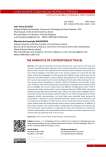
The narrative of contemporary travel
Статья научная
The ways of narrating the journey have become a great way in the early 21st century. They left behind the chatting circles, the film productions, the books and gained space on the Internet. This research aims to know how social networks are used by content creators (bloggers and influencers in the tourism industry) to record the trip and reflect on how the pedagogies in these spaces teach different ways of traveling. For the treatment and data analysis, content analysis was performed. The way of carrying out the research was inspired by the studies developed in Cultural Studies and based on various sources whose composition or content related to traveling, such as books, magazines, websites, and, mainly, blogs and social networks. Among the several authors studied, we highlight the research conducted on the different manifestations of the “self” in contemporary times, among them, texts by Zygmunt Bauman (2008), Gilles Lipovetsky (2016) and especially Byung-Chul Han (2015, 2016). The main results highlight that, in contemporaneity, the consumption of travel reports once made through books, technical magazine articles, documentaries, and even blogs were gradually being replaced by practical tips - which fit in spaces standardized by the creators of social networks such as Facebook and Instagram. In these spaces, users are educated to look at places in fragments. Ready-made lists and itineraries reduce cities to some landmarks. In addition, in these same “spaces,” the travel becomes a stage and the landscapes into scenarios for the most diverse representations, reinforcing the ideas of an ephemeral, transparent, volatile, individualistic, and accelerated life that mark them and teach recipes for traveling that ends up repeating itself on the screens.
Бесплатно
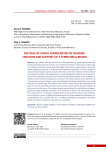
The role of social communities in tourism: creation and support of a territorial brand
Статья научная
This article examines the essence and importance of social media marketing for the promotion of tourist services in an online environment. The purpose of the study is to identify promising ways to boost the target audience by communities in social networks adapted for tourism. A systematic and situational approach, as well as classification, formal and logical analysis and desk research are the main research methods. Based on a literature review on the approaches to understanding the types of social communities and the importance of the correct positioning of advertisements in the formation of loyalty to the territorial branding of customers, the authors present their definition of "community in a social network", give a classification of existing communities, and reveal the features of each type. The practical value of the research lies in the development of ways to use the advantages of each type of social community for the development of tourism in local territories. The authors provide practical tools for identifying and aggregating the target audience in popular social networks in Russia. The main paths of further research are a comparative analysis of the best practices of using social communities in tourism, in order to effectively interact with the target audience and develop recommendations for a content plan of a marketing strategy for promoting a territorial brand and tourist products of a specific local recreation.
Бесплатно
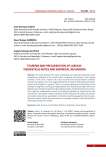
Tourism and precarisation of labour: theoretical notes and empirical incursions
Статья научная
This study discusses the issues of hijacking and capturing subjectivity under manipulative capitalism in the current labour conditions and relations in the tourism economy. In this sense, it points out to the structural trend of precarisation of labour among travel agents, even more aggravated by the demand for high professional qualification and excellence in services. There is a certain adjustment of the worker to the company's imaginary; a feeling of indispensability and worthiness for effort and merit; adhesion and involvement with the organizational whole, materialized by teamwork; belief in effective collaboration at work; and feeling of self-delivery, self-giving and selfcommitment. This implies a labour context of intense imposition of conduct on workers, who need to demonstrate sympathetic and total personality engagement for the reproduction of capital, despite the precariousness of working conditions and relationships in many sectors of tourism activity.
Бесплатно
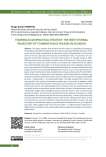
Tourism as geopolitical strategy: the institutional trajectory of tourism public policies in Ecuador
Статья научная
This paper analyzes how tourism has been used as a geopolitical strategy by the Republic of Ecuador throughout the last century, gaining remarkable relevance in the recent period, being considered as an alternative source of development in the context of the restrictive capacities and resources of the National State. In particular, we analyzed the institutional trajectory of tourism public policies in Ecuador, between 19902020, focusing on the role and form of state action in this process. To this end, an empirical study was carried out, based mainly on secondary data collected from the official press of the Republic of Ecuador, in its three branches (executive, legislative and judiciary). From a total of 19,026 documents initially identified, we reviewed and found a total of 223 normative acts specifically dedicated to the tourism issue. This material was analyzed using the institutional model of public policy analysis elaborated by Pimentel (2011; 2014), structured in 3 dimensions and 5 categories, which deals with the normative, regulatory and cognitive dimensions, drawn upon a synthesis of several categories identified by Scott - among others - on institutional theory. The data showed that: a) there is a clear growth in the volume of national normative acts in the period in question, which suggests that tourism has become a State policy, b) the policies are “initiated” and have the executive as the main participating actor, c) however, they are mostly generic acts and poorly linked to operational actions (with plans, projects and measurement instruments) what suggest that extraofficial actions have been taken in order to promote and operate the sector, and d) they are characterized by the absence of resources to make them feasible. We conclude tourism has become a state policy, in terms of the discursive and also institutional level of official actions taken by the national government, as well as the practice we can see in relation to inbound and domestic flows. However, the way the subject is handled lacks support, especially material and financial one, for its effective execution, which suggests that it may have any other - no official and/or institutional - different force driving the sector, while public policies appear as a shadow on the sector's performance.
Бесплатно
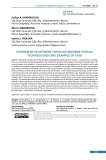
Tourism development through modern virtual technologies (the example of Ufa)
Статья научная
The article considers one of the directions of development of the tourism industry - virtual tourism. Currently, there is a trend towards rapid development and introduction of virtual technologies in all areas of people’s lives. The tourism business is no exception. it most actively uses virtual technologies in the organization of its activities, which help to flexibly and completely segment the development of a competitive tourist offer. Modern tourists prefer non-standard tours with an innovative component. This can be the use of innovative resources, the development of tourist products with innovations, and the use of new forms of service on the route. In the modern period, full of crises, virtual tourism is becoming more and more popular, promising means of promoting any destination, tour. Potential tourists can get acquainted with the sights, cultural, historical and recreational potential of the territory they intend to visit. Then make a choice, stop at the most interesting objects, in the most suitable, exciting places on the planet, while completely free and safe. The authors described the features of tourism development with the help of modern virtual technologies, defined the role and significance of using a virtual tour for modern society and modern business, and offered the author’s virtual tour of old Ufa “Through the times”. Only a virtual tour can reveal the full depth of the proposed route, connect two epochs, and look into the past. Ufa today, and Ufa historical, preserved only in photos, allows you to draw many conclusions about the development of the city, the preservation of historical and cultural heritage, pay attention to the fact that there is a destruction of historical monuments.
Бесплатно
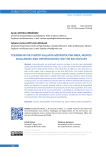
Статья научная
Internationally, sun and beach tourism continue to be the main marketable product for destinations around the world, such as the case of the Puerto Vallarta Metropolitan Area in Jalisco State, Mexico. This article aims to reflect on mass tourism's impact on the region, with a perspective on the first half of the 21st century within the framework of sustainable tourism. The research approach involves qualitative methods such as participant observation, in-depth interviews, and documentary research based on consulting official government sources, data banks, and newspaper analysis. The discussion focuses on the problems associated with the political-administrative aspects of geographical connotation, the challenge of diversifying tourism products with an emphasis on attention to specific growing niches, as well as the ordering of unregulated accommodation and priority attention to social justice to the host population. As a result, the integral planning of the tourist destination is identified as a fundamental issue on which a new stage can be built for the region for the benefit of the resident population, in addition to the diversification of the tourism product considering the micro-regions and its potential within the framework of sustainability.
Бесплатно
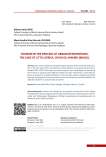
Tourism in the process of urban interventions: the case of Little Africa, in Rio de Janeiro (Brazil)
Статья научная
The article analyses the implementation process of the Porto Maravilha project in the Port Zone of the city of Rio de Janeiro (Brazil), covering the period of one decade (2011-2021). Returning to previous projects, the article begins by describing the territory in question from different models of urban intervention, presenting the space in question as a target of disputes. In this scenario, assets recognized as World Heritage, underground memories and narratives of resistance provide possibilities for reflection about the social function of tourism.
Бесплатно

Tourism strategies of the Northern Europe: comparative analysis
Статья научная
The formation of models and visions for tourism development in the world’s countries differs not only in approaches and tools, but also in the detail and specification of States. Forming the image of the country, strategic development guidelines, defining the contours of tourist projects, understanding the forms of support for the business sector, as well as the development of standard-setting practices is impossible without a clear representation of the target audience. This article discusses the practice of developing national tourism strategies in Greenland, Sweden, Finland, and Norway. These territories are chosen as a comparison base, since the basic environmental conditions in them are almost identical, which complicates the formation of unique strategic landmarks. However, the analysis of documents, national strategies have been identified in the basic terms, which are based on country factors, which emphasize in the future, the conditions that created, creates and will create in the long term for the business sector. Within the framework of national strategies of the Northern EU countries, the mission and vision are set out, key segment groups are fixed, the structure of communication between consumer groups and tourist offers is set out, and the institutional framework for tourism development is set out. It is noteworthy that, in General, all strategies are road map projects, written in the spirit of project management. Recognizing the conditions for sustainable and responsible tourism as a base, the Nordic countries ‘ tourism strategies include requirements for all project parties: tourists, tourist companies, tourist associations, and government representatives.
Бесплатно
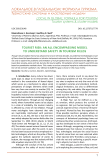
Tourist risk: an all encompassing model to understand safety in tourism fields
Статья научная
Though risk perception theory has advanced a lot over the last decades, its preferred methodologies much of them closed-led questionnaires or intrusive instruments obscures the derived conclusions. This text aims not only to explore the problems and limitation of risk perception theory to understand the difference be- tween fear, anxiety, panic and risk, but also the tourist-safety. The adoption of risk research, post 9/11 was based on quantitative methods alone. This creates a serious conceptual myopia to understand the connec- tion of risk and late-capitalism. Our attempt to fulfill this gap is shown in this essay-review
Бесплатно

